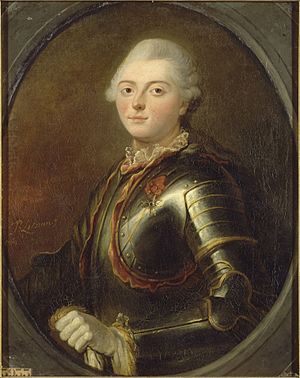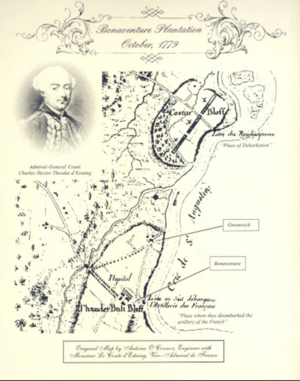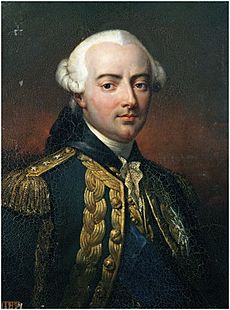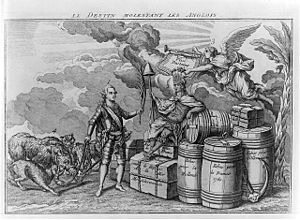Charles Henri Hector d'Estaing facts for kids
Quick facts for kids
Charles Hector, comte d'Estaing
|
|
|---|---|

Portrait by Jean-Baptiste Le Brun, 1769
|
|
| Born | 24 November 1729 Château de Ravel, Auvergne |
| Died | 28 April 1794 (aged 64) Paris |
| Allegiance | |
| Service/ |
|
| Rank | Lieutenant General, Admiral |
| Battles/wars | War of the Austrian Succession Seven Years' War American War of Independence |
Charles Hector, comte d'Estaing (born November 24, 1729 – died April 28, 1794) was a French military leader. He served as both a general in the army and an admiral in the navy. He started his career as a soldier during the War of the Austrian Succession. Later, he became a prisoner of war for a short time during the Seven Years' War. His brave actions at sea during that war made him switch to the French Navy.
In 1778, France joined the American War of Independence. D'Estaing led a fleet to help the American rebels. He took part in a failed attack on Newport, Rhode Island in 1778. He also led an unsuccessful attack on Savannah in 1779. However, he had some victories in the Caribbean before going back to France in 1780. It is believed that his difficulties working with American leaders were a reason for the failures in North America.
Even though d'Estaing supported the changes during the French Revolution, he remained loyal to the French royal family. Because of this, people became suspicious of him. He was later executed by guillotine during a period known as the Reign of Terror.
Contents
Early Life and Military Start
Charles Hector was born on November 24, 1729, at the Château de Ravel in Auvergne, France. His father was a high-ranking general in the French Army. His family had a long history of serving the French king. Young d'Estaing grew up with Louis, who was the son of the king and would have been king himself. They became close friends.
When he was nine, d'Estaing officially joined the musketeers. His noble family wanted him to have a military career. He moved up the ranks quickly. In 1746, he became a lieutenant in the Regiment de Rouergue. That same year, he married Marie-Sophie. His regiment fought in the War of the Austrian Succession. D'Estaing served as an aide to Marshal Saxe from 1746 to 1748. During this time, he became a colonel in charge of his regiment. He was hurt during the Siege of Maastricht in 1748.
After the war, King Louis XV wanted to make his army better. D'Estaing became one of the main people working on these changes. His regiment became a model for other infantry units. He also spent some time in England with the French ambassador to learn about diplomacy.
Seven Years' War in India
When fighting started between British and French colonies in North America, d'Estaing wanted to join the forces sailing in 1755. But his family told him not to go. Later, when an expedition to the East Indies was planned, he decided to join without telling his family. He was promoted to brigadier-general, which helped him go. In January 1757, he received the Order of Saint Louis.
Fighting Under Lally
After a long journey, the French fleet arrived in southern India on April 28, 1758. The land commander was the count de Lally. French forces quickly took the town of Cuddalore and began to attack Fort St. David. D'Estaing helped lead the attack. The fort surrendered after 17 days. He continued to fight under Lally in India. He disagreed with Lally's choice to stop the attack on Tanjore.
In December 1758, Lally began to attack Madras. D'Estaing's group was in the middle of the French line. When the British attacked that area, d'Estaing went forward alone to see what they were doing. He was surrounded by British soldiers, fell off his horse, and was wounded twice before he gave up.
The British took d'Estaing to Madras and held him prisoner. He was offered a chance to be released if he promised not to fight against the British in the East Indies. He first refused, wanting to be exchanged for another prisoner so he could keep fighting. But when a British fleet arrived, he accepted the offer. In May 1759, he sailed to Île-de-France (now Mauritius).
Service for the French East India Company
While d'Estaing was in Île-de-France, he learned about a prisoner exchange deal. But he was not included because he had been released earlier. So, d'Estaing decided to work for the French East India Company. He led a naval trip to get supplies for Île-de-France. He planned to say he was just a "spectator" if they met British forces.
In September 1759, d'Estaing sailed to the Persian Gulf with two company ships. He learned about a British ship at Muscat. Fifty of his men bravely entered the harbor and captured the ship. They also destroyed the British trading post at Bandar-Abbas. D'Estaing then sailed to Sumatra. He had great success, getting many valuable goods with only a few injuries.
In February 1760, d'Estaing's fleet reached Sumatra. He captured the British trading post at Natal. He then attacked Tappanooly, another British outpost. Its commander fought hard but fled. D'Estaing destroyed the fort. Next, he went to Padang, a Dutch settlement, to get more supplies and local fighters.
He then sailed to Bencoolen, the main British settlement on Sumatra. The town was protected by Fort Marlborough. The defenders were warned of the French arrival. But when d'Estaing's ships fired their first shots, the defenders panicked and ran into the jungle. D'Estaing used Fort Marlborough as a base to take over other smaller British settlements. He returned to Île-de-France after ten months.
D'Estaing was ordered back to France. His ship was captured by British patrols near the French coast. He was held in Plymouth and accused of breaking his promise not to fight. He successfully defended himself and was allowed to return to France. When he arrived, he was made a field marshal for his service in the East Indies.
Between Wars
Governor of the Leeward Islands
In 1762, France planned a big expedition against Portuguese lands in South America. D'Estaing was promoted to lieutenant general in the army and rear admiral in the navy. To make his command clear, the king officially moved him from the army to the navy as a lieutenant general. However, the expedition was canceled when peace talks began.
In 1764, King Louis made d'Estaing the governor general of the French Leeward Islands. He held this job until 1766. He was mainly based in Saint-Domingue (now Haiti). He tried to get Acadians to settle there. The British had forced them out of their homes in Canada during the war. But many Acadians died from tropical diseases, and others moved away because of the hot climate and poor land.
Service in France
D'Estaing returned to France in 1767. In 1772, he became a naval inspector and governor at Brest, which was France's main Atlantic naval base. In 1777, he was promoted to vice admiral for the Asian and American seas.
American War of Independence
When France joined the American War of Independence in 1778, D'Estaing left Toulon with a fleet of twelve large warships and four smaller ones. His goal was to help the American colonies fight Great Britain. He sailed on April 13. From July 11 to 22, he blocked the smaller British fleet of Lord Howe near Sandy Hook, New Jersey. He did not enter New York harbor because his biggest ships were thought to be too large to cross the sandbar at its entrance.
Newport Attack
D'Estaing planned an attack on Newport, Rhode Island with American generals. Before the attack, he forced the British to destroy some of their warships in the harbor. But before the combined attack could happen, he sailed out to fight the British fleet under Admiral Howe. A strong storm suddenly hit, forcing the two fleets to separate before they could fight. Many of d'Estaing's ships were damaged, so he had to go to Boston for repairs. He then sailed to the West Indies on November 4.
West Indies Battles
He arrived in the West Indies in December 1778. The British had just started to capture St. Lucia. D'Estaing tried to help the island, but he was defeated in both land and sea efforts to stop its capture.
In June 1779, his fleet was made stronger by ten more warships. He took advantage of the British Admiral John Byron being away. D'Estaing sent forces to capture St. Vincent on June 18. Then he sailed with his whole fleet to capture Barbados. When he could not make progress against the strong winds, he turned his attention to Grenada. On July 2, he arrived at the island, and his forces took it by storm two days later.
Admiral Byron learned about the capture of St. Vincent. He was sailing to retake it when he found out d'Estaing was at Grenada. He changed course and sailed quickly to Grenada, arriving on July 6. Even though d'Estaing knew Byron was coming and had more ships, he quickly loaded soldiers and sailed away from the island. Byron, not knowing d'Estaing had more ships, ordered a general chase. This led to a somewhat messy battle. D'Estaing did not fully use his advantage in numbers. Both fleets eventually went back to their bases for repairs. In August, d'Estaing sailed to Savannah, Georgia, to join American forces who wanted to take back the city from the British.
Siege of Savannah

The siege of Savannah was a joint French and American effort to retake the city from the British. It lasted from September 16 to October 18, 1779. D'Estaing was in charge of all the combined forces. After weeks of bombing, a major attack on October 9, 1779, failed. During this attack, d'Estaing was wounded twice. When the attack failed, d'Estaing ended the siege. British forces kept control of coastal Georgia until they left near the end of the war.
Later Years and Death
D'Estaing returned to France in 1780. He was not as popular at court and was criticized by some of his officers. Friends of Benjamin Franklin, who was then a minister in France, joked that the French court should give America the names of other talented admirals.
In 1781, France sent a fleet under Admiral de Grasse to help the Americans in Virginia. Admiral de Grasse defeated the British in the Battle of the Chesapeake. This helped the British army surrender at Yorktown in 1781.
Three years later, d'Estaing was put in charge of a French-Spanish fleet gathered near Cádiz. But peace was signed between the US, Great Britain, and France, so no battles took place.
After the American war, d'Estaing became interested in politics. He was made a grandee of Spain. In 1787, he was chosen for the Assembly of Notables. When the French Revolution began, he supported the revolutionaries. In 1789, he became the commanding general of the Versailles National Guard. In 1792, the National Assembly promoted him to admiral. While he supported new reforms, he remained loyal to the royal family.
During the trial of Marie Antoinette in 1793, d'Estaing spoke in her favor. Because of this, and some friendly letters between him and the queen, he was put on trial himself. He was accused of being against the revolution. He was executed by guillotine on April 28, 1794. Before his death, d'Estaing wrote a message for the British. Both his wife and his only child had died before him.
In his free time, d'Estaing wrote a poem called Le Rêve (1755), a play called Les Thermopyles (1789), and a book about colonies.
Images for kids
-
An October 1779 map by Antoine O'Connor, d'Estaing's chief engineer, of the coastline to the east of the Savannah colony, including Bonaventure Plantation
See also
 In Spanish: Charles Henri de Estaing para niños
In Spanish: Charles Henri de Estaing para niños









